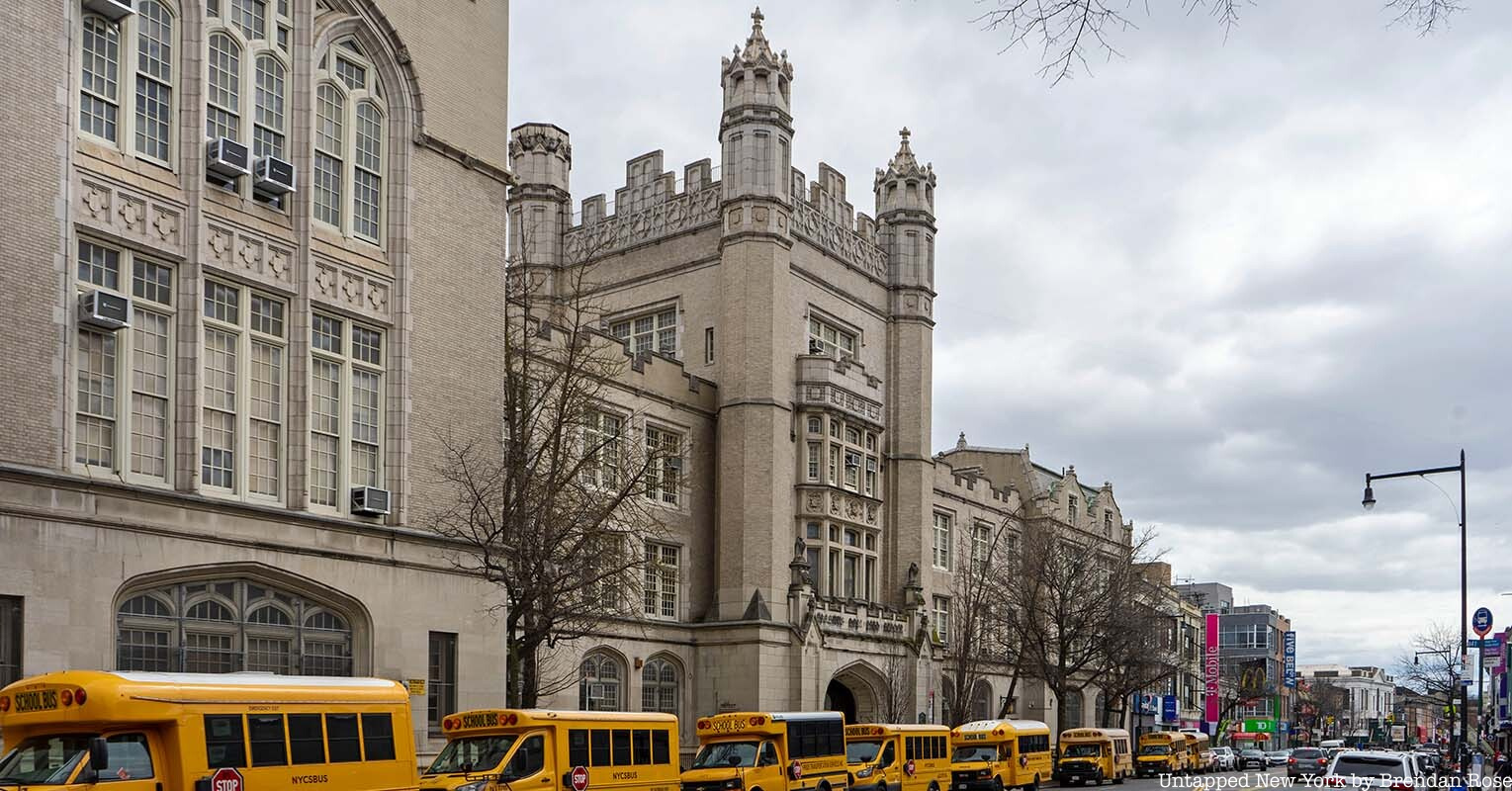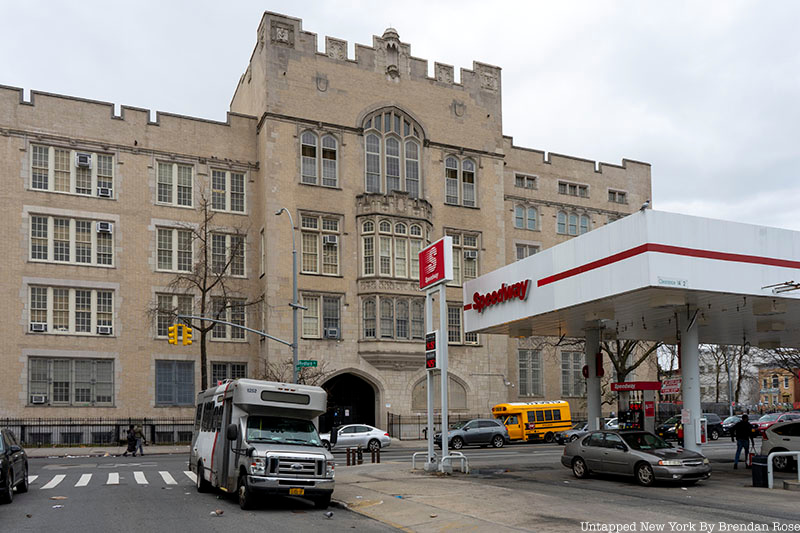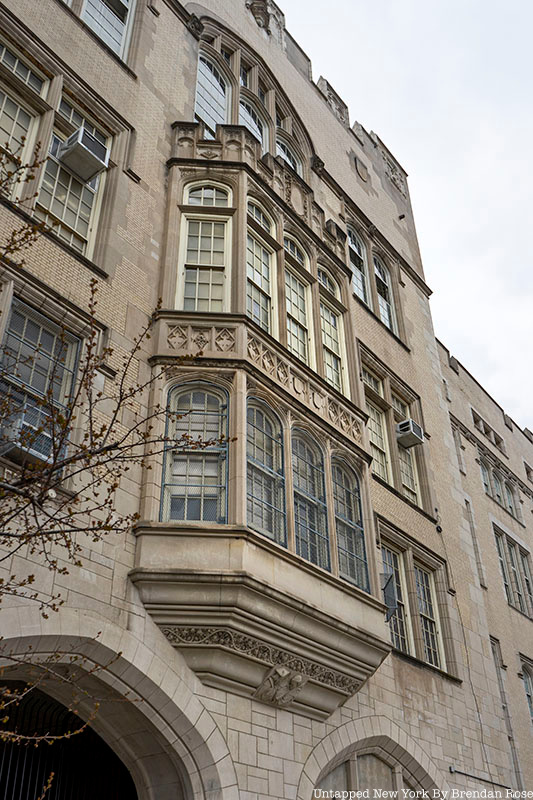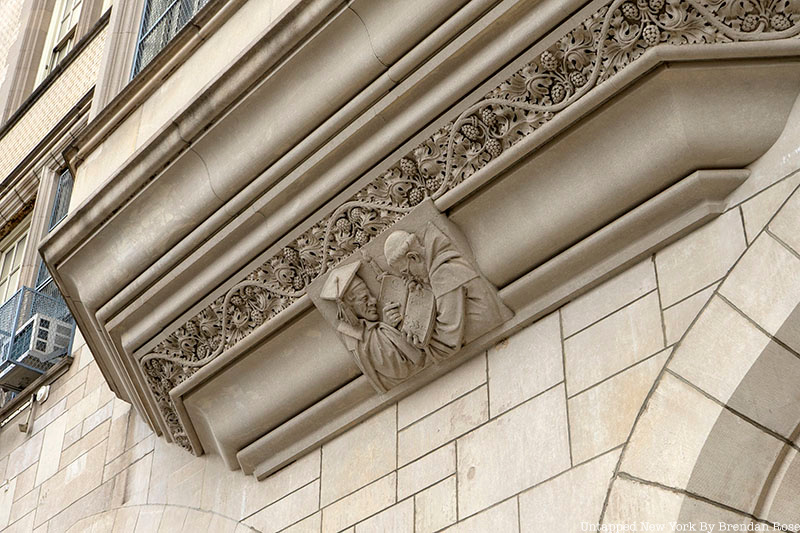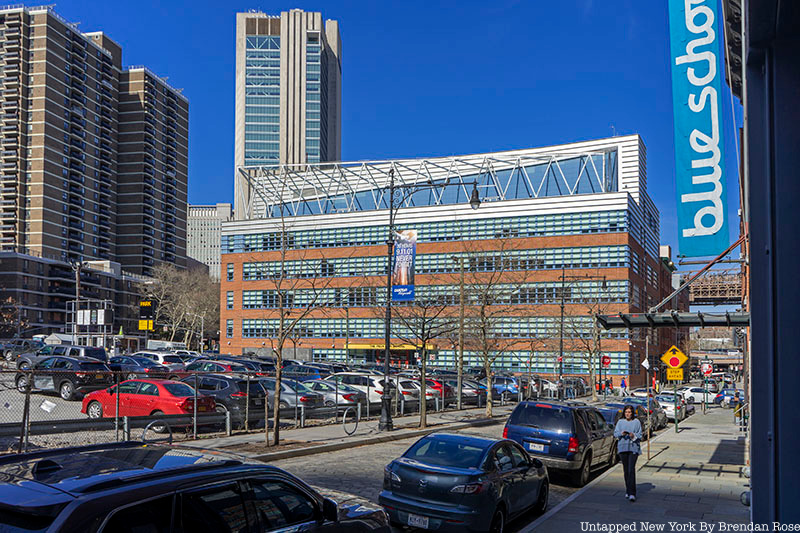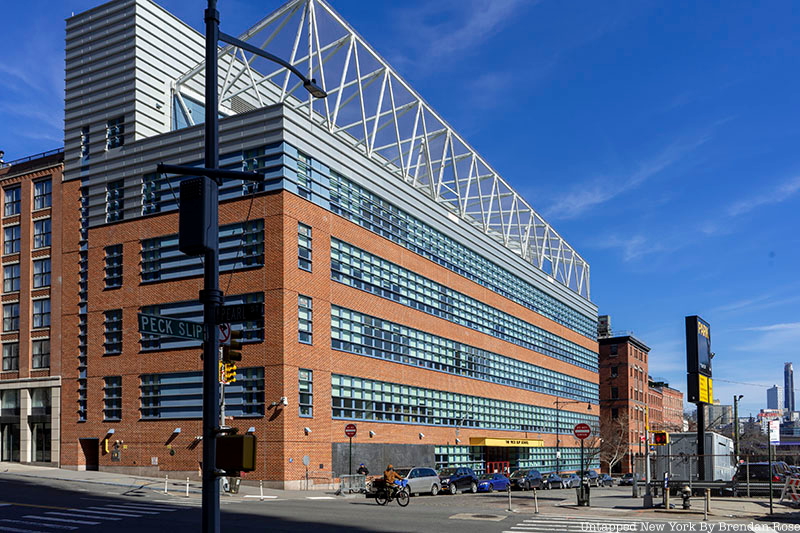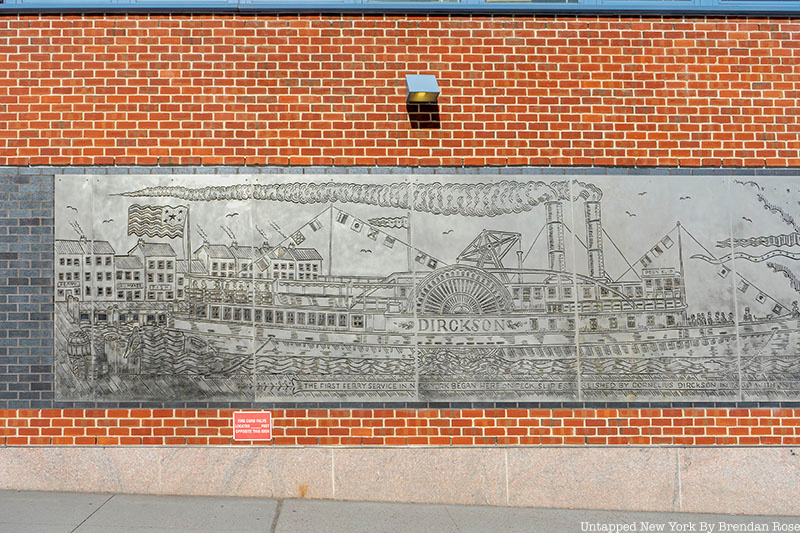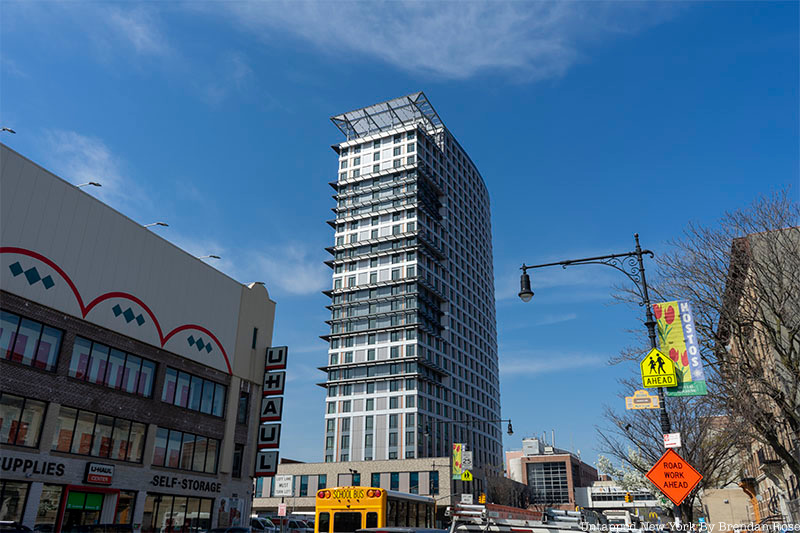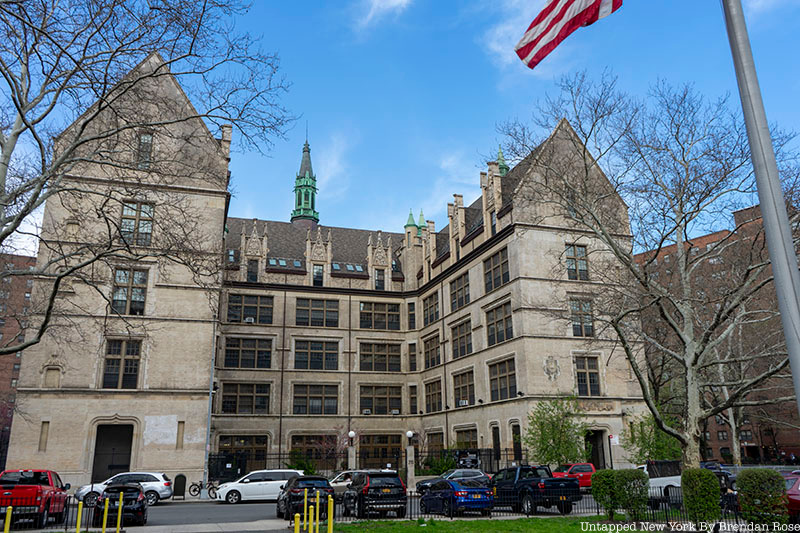In the face of a crisis, one architect built a generation of amazing school buildings, changing the lives of thousands of New York City students. But his design philosophy did not last, raising the question: Why do some New York City schools look like cathedrals and others look like prisons?
The tall Gothic towers of the Erasmus Hall buildings stand in stark contrast to the bustling storefronts of Flatbush Avenue in Brooklyn. The high school building’s facade is ornamented with limestone and terra cotta carvings and Oriel windows, and crowned with crenelated parapets. The Collegiate Gothic design of the building would not look out of place on the campuses of Harvard or Cambridge. But unlike those institutions, this is a public school, open to everyone, not a select few. The Erasmus Hall Educational Campus is one of many equally beautiful public school buildings across the five boroughs, designed by the architect C. B. J. Snyder. Snyder had a vision for New York City schools; he believed they could be cathedrals of learning.
In our upcoming talk with the great-grandaughter of C.B.J. Snyder on August 9th where we’ll explore Snyder’s extensive catalog of work as written about in the book From Factories to Palaces: Architect Charles B. J. Snyder and the New York City Public Schools by the late Jean Arrington. This talk will be led by Cynthia Skeffington LaValle and Michael Richard Janoska, part of a team who saw the book to completion after Arrington’s unfortunate diagnosis of Multiple Systems Atrophy (MSA) in 2018 and her passing in 2022.
This talk is free for Untapped New York Insiders! Not an Insider yet? Become a member today and get the first month free with code JOINUS. Untapped New York Insiders gain access to member-exclusive virtual and in-person experiences, as well as our on-demand archive of over 200 webinars!
Snyder was put in charge of New York City’s school buildings at a moment of dramatic change for schooling in the city. In the decades leading up to his appointment in 1891 as Superintendent of School Buildings, overcrowding had pushed the system to its breaking point. The city’s immigrant population had exploded, and after 1874 primary school attendance became compulsory. Snyder came in with a mandate from the city to build sufficient schools to alleviate the strained system.
Erasmus Hall is one of the city’s best examples of Snyder’s approach to fulfilling that mandate. The original school building built in the 18th century still stands in the center courtyard, surrounded by towering Snyder-designed buildings. What started as a modest clapboard schoolhouse expanded into a massive complex with hundreds of classrooms and thousands of students.
The older generation of schoolhouses were often poorly ventilated and lit with gas lamps, making the overcrowded classrooms a serious fire hazard. The poor state of the buildings prompted the city’s newspapers to publish scathing exposés on the conditions in schools. As a result, school reform became folded into a greater movement to improve living conditions for the poor, led by galvanizing figures like Jacob Riis. Simultaneously, the City Beautiful Movement promoted by the upper-middle class fostered the idea that beautiful architecture and urban planning could influence the lives of the public.
“There was a sense that civic buildings had to ennoble,” Peg Breen, the president of the New York Landmarks Conservancy, told Untapped New York, adding, “that you were creating for civic beauty, and you were trying to say that the events that went on inside these buildings were important.”
Snyder grew up in Saratoga Springs, N.Y., where as a child, he watched a number of the resort town’s grand hotels burn down, a trauma that may have motivated him later in life. He would then move to New York City to study architecture at Cooper Union. Snyder seemed to have had certain political connections because at only 30 years old he was appointed to the superintendent position, replacing George Debevoise, who had left suddenly following corruption allegations.
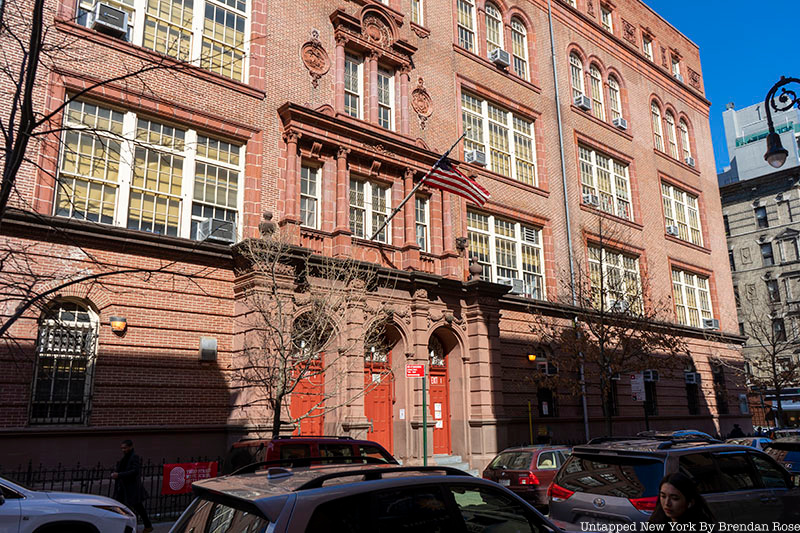
In his new position, Snyder prioritized fire protection, ventilation, lighting, and classroom size. He created a style of interlocking staircases specifically designed to make evacuating the building as fast as possible in case of a fire. The classrooms had large windows letting in natural light and circulating fresh air. He embraced the concept of an H-shaped building footprint, which created protected courtyard space in the middle of closed city blocks.
The schools often had ornately decorated auditoriums, gymnasiums, and swimming pools. Snyder built playgrounds on the roofs of the school buildings, maximizing the available open space. The schools could now accommodate after-school arts and recreational programs and vocational and language night classes. Unlike their predecessors, the buildings became centers of their communities.
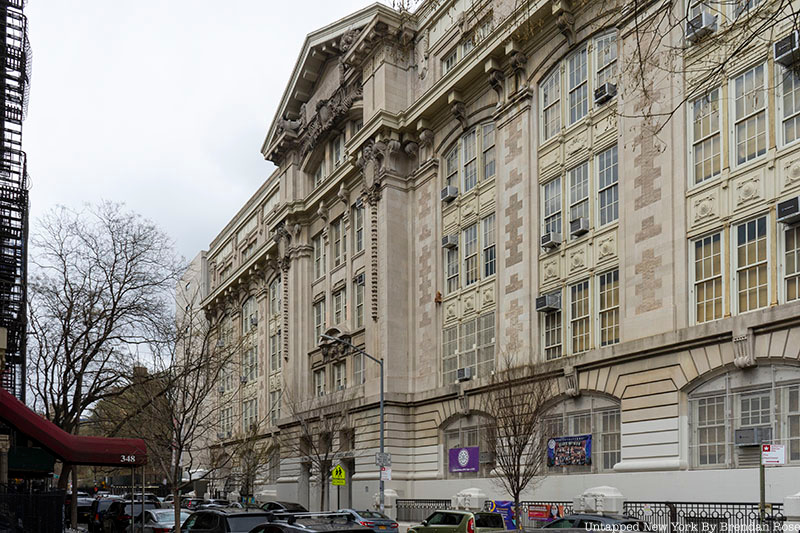
Snyder designed buildings in a host of architectural styles mostly inspired by the opulence of the Renaissance and Baroque periods in Europe. Stately British styles like English Collegiate Gothic and Jacobean made some schools look like castles or the mansions of the English aristocracy. Others utilized Beaux-Arts elements fashioned after the grand hotels and museums in Paris. And in some, observers can notice stepped gables, hinting at the city’s Dutch roots and Dutch Colonial architecture.
“New York has one of those rare men who open windows for the soul of their time,” Jacob Riis wrote of Snyder in his 1902 book, The Battle With the Slum. “He found barracks, where he is leaving palaces to the people.”
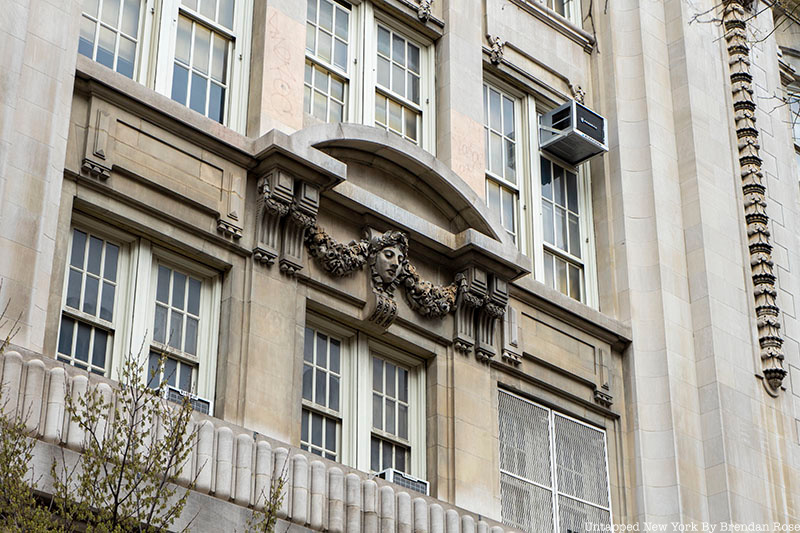
A decade into Snyder’s tenure as superintendent of buildings, Brooklyn, Queens County, and Staten Island were consolidated into New York City, giving him an even wider influence. By the time of his retirement in 1923, he was credited with designing hundreds of schools across the city.
“I am tired and completely worn out,” he said, according to an article in the New York Times. He had not taken a single vacation since 1904.
Now a century later, many of his schools are still in use. Along with Erasmus Hall, examples include Morris High School in the Bronx, Flushing High School in Queens, Curtis High School on Staten Island, and the original Stuyvesant High School Building in Manhattan. Across the city, thousands of students still depend on his buildings.
Snyder’s legacy of innovative and beautiful design did not survive after he stepped down from his position as superintendent. New school buildings built in the 1960s and ’70s were significantly stripped down and utilitarian, often massive brick and concrete boxes lacking the grandeur and character of Snyder-era projects.
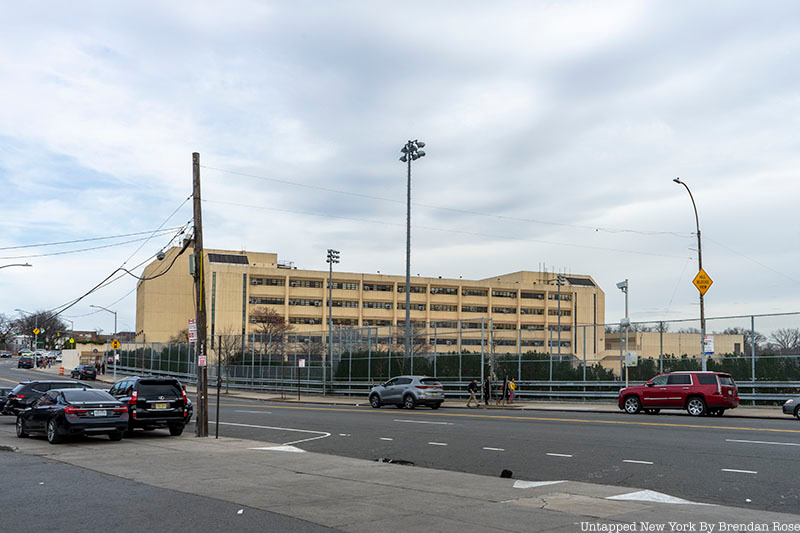
It is hard to pinpoint exactly why this shift occurred. New York City’s changing demographics undoubtedly played a role. White flight out of inner-city neighborhoods and the public school system led to budget slashing as the city spiraled into the fiscal crisis of the ’70s. During his tenure, Snyder operated with a Robert Moses-like level of autonomy, which later city officials and architects did not have.
While beauty is in the eye of the beholder, the austere and uninviting designs of Lehman High School and Edward R. Murrow High School in Brooklyn, for example, exemplify the profound shift away from Snyder’s philosophy.
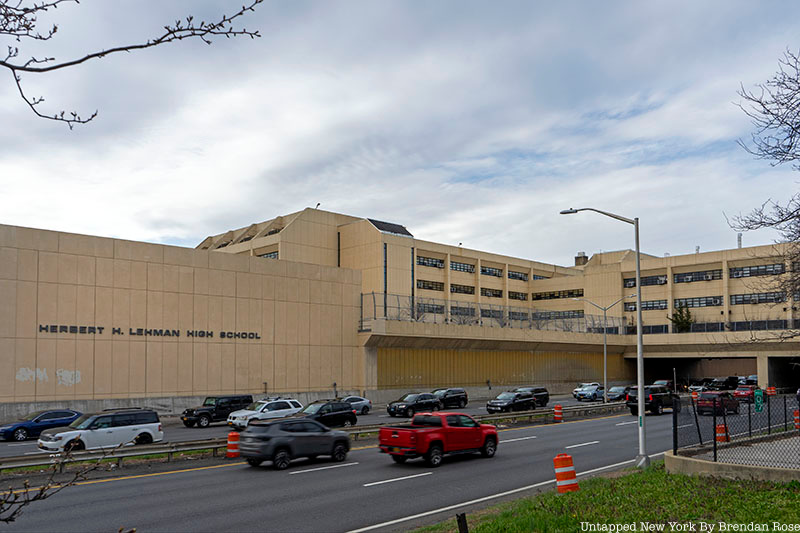
But in recent years, the city has rethought its school design philosophy. Two projects stand out as being architecturally exceptional. The new Beacon High School on the West Side of Manhattan, designed by John Ciardullo P.C., and the Peck Slip School, designed by Michael Graves Architecture & Design, both repurpose existing industrial buildings, turning them into state-of-the-art sustainable buildings.
Some of Snyder’s works have been lost forever after the buildings were torn down and the sites redeveloped. Others were abandoned and have fallen into disrepair. PS. 31 was a landmarked building in the South Bronx affectionally called “The Castle On The Concourse,” but after years of sitting abandoned, it was torn down and replaced with luxury apartments. But public outcry by communities and preservationists to landmark his projects has ensured the protection of many of the schools. Additionally, some buildings have now been repurposed into affordable housing, museums, and community centers.
Snyder was part of a time in New York’s history when public works were seen as egalitarian monuments for all New Yorkers. Train stations, libraries, and schools became iconic pieces of New York’s architectural fabric. Today, public projects must undergo a significantly more arduous political and bureaucratic process. But what the Beacon and Peck Slip projects show is that there is an understanding that quality building design does affect the learning experience of its students, and that part of Snyder’s legacy is preserved.
Breen believes that Snyder should be better recognized. “I think maybe, internally there have been people who understand Snyder, and his importance,” she said. “Overall he needs a real fan club and deserves a real fan club and deserves to be kind of in the pantheon.”
Next, read about 10 gorgeous Beaux-Arts buildings in NYC!






